One of the more intimidating aspects of wargaming the First World War, and thus a hurdle to getting started, is the perceived scale of the conflict. It immediately conjures masses of men going over the top, large scale artillery barrages, and the sinking terror that you might have to build a trench table.
The type of thing on might see in 1917 or All’s Quiet on the Western Front.
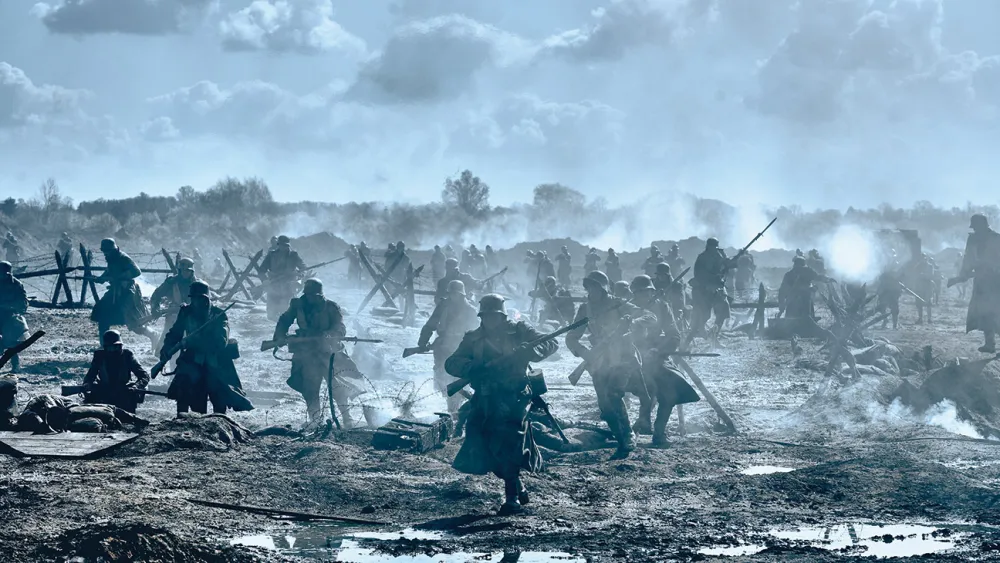
Doubtlessly spectacular, hugely intimidating, and at 28mm, potentially a testament to a gaming group’s unchecked hubris.
Scouts Out: Raids and Reconnaissance in 1914-1918 (hereafter Scouts Out! – how the author refers to it throughout the book) is a very different game. Meant to focus on the small patrols and raids that crept out a night into No Man’s Land, and the small but bloody conflicts that ensued, Scouts Out! was written by Chris Kelley, a self-confessed father of five kids, to hammer out short games that can fit on a coffee table. And this, it absolutely accomplishes.
[Editor’s Note: Summer 2024 marks the 110th anniversary of the cataclysmic events that led to World War I. Despite being one of the most pivotal events of the 20th century, WWI has not achieved nearly as much representation on the tabletop as its sequel, and we at Goonhammer hope to shine a little light on this fascinating period of history.
Therefore, Goonhammer is pleased to present our Guns of August summer event. Every Monday, from June to August, will see a new article on wargaming the Great War. Expect painting guides, model reviews, interviews, ruleset spotlights, and more!]
Requirements to Play
As stated above, Scouts Out! is extremely light weight. You’ll need some miniatures – almost certainly fewer than two dozen of them, a few d6’s, a tape measure, and a 36″ x 36″ surface to play on. And that’s really about it.
Even the terrain is fairly light weight – the game does a good job of not just focusing on trench raids, so some ruined buildings, a few modular trenches, some walls, barbed wire, craters and the like should do you just fine for most games.

Army Selections
A “Raiding Party” – the basic force in Scouts Out! – is made up of an eclectic mix of men chosen to the mission at hand, ranging from experienced, well-equipped specialists to some poorly equipped, barely trained, and probably terrified conscripts. A standard game is 250 points, and said veterans can range into the 30+ points category, while conscripts can come as cheap as 8.
Generally speaking, you have 0-2 choices for “Headquarters” units — officers and NCOs, 0-3 choices for “Specialists” such as Medics, Snipers, Sappers, etc., a requirement to take 2+ “Grunts” who are typically infantry but can also include cavalry and marines, and 0+ “Raiders”, who are, as the name suggests, trench raiding specialists, such as German Sturmtruppen. Rounding this out is 0-1 “Heavy Equipment” choices, which typically involves crew-served machine guns.
It’s a flexible system, and one that can mean several raiding parties built from the same list can play very differently. The game includes lists for four of the “Great Powers”, each with some special rules.
British Expeditionary Force
The British are considered a professional army, and as such can only take “Professional” or “Veteran” level Grunts to fill their 2+ choices. No cheap conscripts for them. In exchange, they get the “Mad Minute” rule, which means they can rapid fire their rifles with no penalty as long as they don’t move – pushing them towards a very effective but not particularly mobile base of fire.
They have a very dangerous Pointman in their Specialists that can take out a unit in close combat if they’ve charged out of the normal sequence, which can be brutally effective, and a wonderfully characterful Sapper who can create a new deployment area by tunneling — assuming it doesn’t collapse on him. The perfect choice for anyone with a strong urge to have Tommy Shelby as part of your squad.
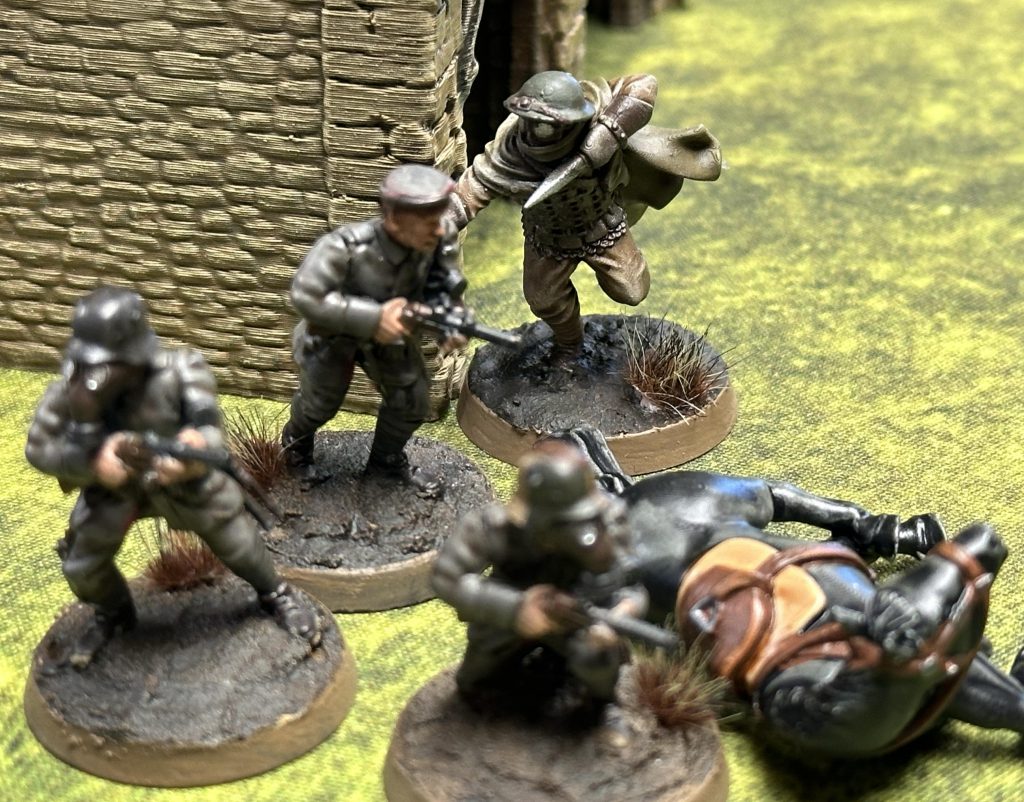
Imperial German Army
Reflecting German tactical doctrines allowing initiative at lower levels, the Germans can elect not to take officers to fill their HQ slots, freeing them up for more basic infantry, which can provide a numbers edge at the cost of the re-rolls some officers provide. They also benefit from the “Sturmtruppen” rule, which gives their Specialist, Raider and Grunt units an extra 3″ to their basic movement (i.e. not running), which means they can cover a lot of ground very quickly, flitting from cover to cover. Very handy if one is, for example, hypothetically facing off against high volumes of British rifle fire.
The Germans come with a lot of potential advantages in weaponry — submachine guns are widely available for their Sergeants and Sturmtruppen raiders, Pioneer teams can bring flamethrowers to bear, and the German Sabetour can secretly booby-trap a piece of terrain to turn into an inferno when their opponents come near it.
All that being said, those things are often quite expensive.
French Armed Forces
The French Army gets a smattering of benefits — “Plan 17” covers their doctrines around fortifications, and gives a French unit +1 cover if they don’t move, while “Bounding” means a French grunt can shoot and then move up to 6″, but cannot shoot again in the phase. That’s decent, as it allows shooting in the movement phase, which could potentially take out an opponent before they were able to return fire, but the two rules push the French in somewhat opposite directions.
Charmingly, the French can also make all their units 5 points cheaper by painting them in their bright red and blue uniforms of the very early war, at the cost of being easier to hit. Anyone who does this is to be complemented on the bravery and élan of their valiant forces.
French special units include Flamethrowers, an Engineer that can fortify a single face of terrain, making it potentially nearly unassailable, and generous cavalry options.
Austro-Hungarian Imperial and Royal Army
While a mouthful to say, the Austro-Hungarian Empire is an interesting mixed bag, and feels a bit like “I needed to have two armies on either side”. Several of their units can simply be taken in German raiding parties as an allied force, and a shortage of supplies and equipment mean their upgrades are more expensive.
Taking a very expensive (40pt) German captain also lets you take German Grunts in your raiding party. The good news, I suppose, is you can take dirt cheap Galacian conscripts for 8 pts. each for a “Boys Before Toys” approach, and Austrian Jaegers, who are essentially riflemen with sniper cloaks, are extremely hard to root out of cover.
Gameplay
As befits a game of this type, Scouts Out! is very straightforward. Units have four stats, with the values of those stats dependent on their skill level (i.e. Veteran, Professional, or Conscript):
- Shooting: How good you are at shooting
- Defense: How good you are at not being shot
- Training: How well you navigate terrain, perform special actions, etc.
- Combat: How good you are in close combat
That’s it. Everyone moves 6″ and runs 6″ plus their training value. Weapons are similarly represented in broad classes – pistols, rifles, sub-machine guns, light machine guns, etc. rather than specific models.
Shooting is handled by the firing model rolling a d6, and then adding their Shooting score. For example, a Professional has a Shooting of 3, and rolls a 4, for a total of 7. The model being shot at rolls a d6, and adds their Defense score. For example, a Veteran has a Defense of 4, and rolls a 2, for a 6. They then take any modifiers into account, from penalties to rapid fire for bonuses to defense for being in cover. If the attacker meets or beats the defender’s score, they’ve hit. They then roll to see if they wound, on a single D6, with the score needed ranging from 2+ for a Sniper Rifle to 5+ for a pistol.
That’s the entire mechanic. Some guns can take more than one shot, either innately, with a penalty, or both, but rare is the weapon with more than a few special rules, and most of them are straightforward.
Assaulting is even more direct, and extremely violent. Once models move in base to base contact, each player rolls a d6 and adds their Combat score, plus any modifiers for things like armor or carrying close combat weapons. If it’s a draw, you roll again. The winner kills the loser, or captures them (some missions require this). If you’re fighting multiple people, you fight them one at a time, with a -1 penalty to your roll for each. In my experience, once raiding parties close with each other, the game is going to go one way or the other in very short order.

While I’ve found there’s some slow-down in adding up whether one score has beaten the other, vs. a target number, overall it’s a very fast system. There is one bit of ambiguity I’ve found, which is how activation is done. The author describes it as an “I go, You go” system, and the description of the rules seem to match:
When it’s a player’s turn, they will perform all appropriate actions of that phase available to them, then the turn will switch to the other player.
Easy enough. The problem is, the example right below it:
Think of it as chess, the player with the higher initiative will activate and move 1 model, then the opposing player will do the same. Once all players have activated and moved their models it moves onto the shooting phase.
This seems to be describing an alternating activation sequence. I don’t think there’s anything particularly game breaking about either reading, and I’ve played it both ways. My group has house ruled running via alternating activations, as it makes losing the initiative roll to a bunch of SMG wielding stormtroopers slightly less devastating, and lessens the potential for “feel bad” moments.
Overall Impressions
Having played a number of games of Scouts Out! with my club’s historicals group, [Editor’s note: the only important group, obviously] it’s fun and it’s fast, which is exactly what it’s supposed to be. Even goofing around and chatting, I’ve never had a game go longer than 45 minutes. The missions are also pleasantly varied, and many of them take place beyond No Man’s Land – for example, one mission involves raiding a farm house for prisoners.
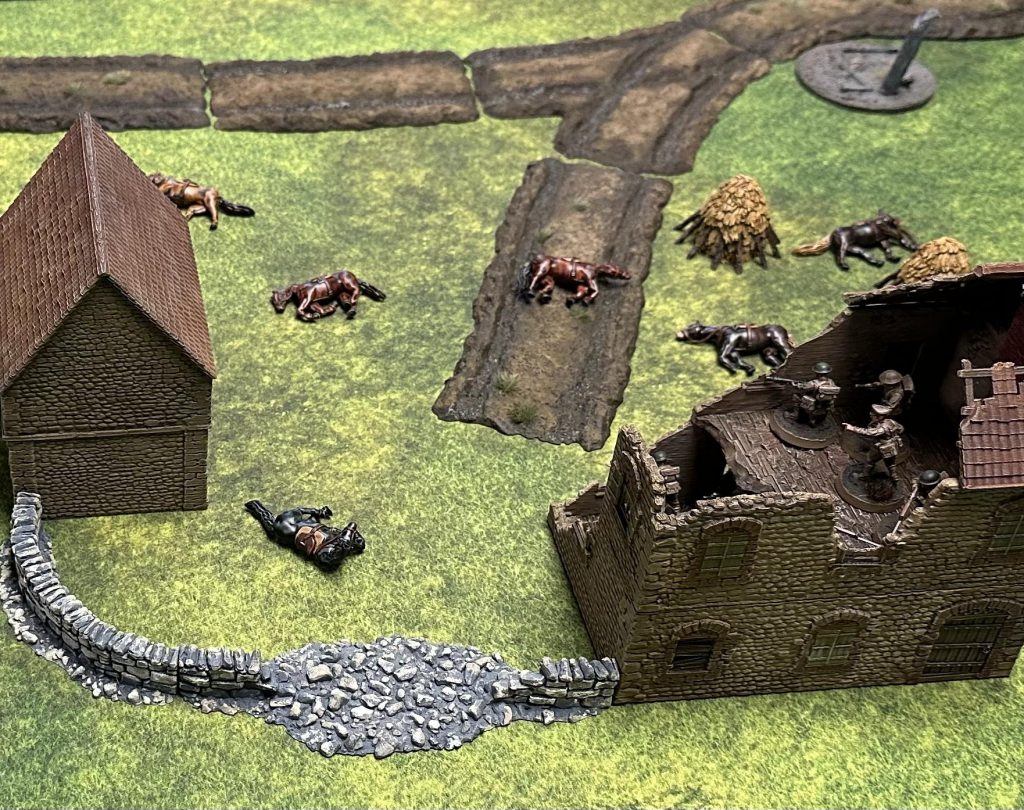
The game is admittedly somewhat ahistorical, in that there are a plethora of weapons that should be vanishingly rare. But I found I didn’t really mind this, and I did get the feel of close, brutal combat that is really what the game is looking for. The opposed dice mechanic can often mean that not much happens for a bit, but in all of the games I’ve played, there seems to be a turning point where one side starts giving way – usually when a moment before, things were alright. The biggest learning curve for me was learning not to rapid fire at units in good cover unless you could do it without penalty (i.e. the British “Mad Minute” ability), as taking a -3 penalty to your roll (or worse if they’re behind sandbags) meant for evenly matched “Professional” skill soldiers the defender had such an overwhelming advantage that even if I rolled a 6 they had a 66% chance of successfully defending.
Is it a game I’d play every week? Probably not. But it’s great fun if you want to knock out a couple games with not a lot of time investment, are trying to squeeze a game in in a tight schedule (say, one with five kids…), or are looking for a sort of “appetizer” game to set the stage for a larger game system. It’s also got a fair amount of solitaire suitability – outside the German Saboteur’s ability, there’s almost no hidden abilities, interruption abilities, etc. that would be negated by knowing the other side’s plans.
Expansion
There’s also an expansion to Scouts Out! that, it should be noted, still requires the main rule book. It has a lot of the same material, so it’s easy to mistake it for a replacement book, but it’s missing the core rules and missions.
What it adds are a few new types of weapons and accompanying equipment that were missing from the original book, but do feel definitive for the Great War: gas and grenades. Grenades use the “Small Blast Template”, which is never defined, but is provided in the back of the book, and handily provides both the area of the blast and the way it scatters. To not scatter, you have to pass a training test on 1D6 and then also roll a 6, which will only occur 11% of the time, and feels like a lot of rolling for effectively a 9-in-10 result of “Yep, it scatters…” which involves another die roll.
Gas is essentially a mission overlay – a large blob of gas is placed on the map, and then it drifts, incapacitating anyone without a gas mask on a 2+, and making it harder for those who are better prepared to fire out. It’s a good addition to the game, and could make some defender-friendly missions like trench raids a little easier on the attacker.
Also added are rules for night fighting, which slows everything down, makes it harder to shoot, and makes the Training score far more important.
The heart of the expansion though is the addition and revision of the army lists, including several new nations. Broadly, most nations see the addition of a Spotter for their Sniper units, the addition of Mortar teams, and the ability to purchase barbed wire obstacles.
American Expeditionary Force
The Americans get to pick which Division they come from, and the accompanying special rule. The 1st Infantry Division gets cheaper troops at the cost of no Veterans, the 3rd Infantry Divisions gets a bonus of cover from terrain, and the 2nd Infantry Division as well as the Marines get +1 to all melee combat rolls if they charge.
Special units for the Americans include a Lakota Code Talker, which allows for redeployment of units near them, “Heavy Infantry” as a grunt option, and shotgun-armed Trench Raiders.
British Expeditionary Force
The British lost the “Captain” option, who was largely useless and mostly served to risk -5 VP if they got killed. They also gain the “Pals Battalion Infantry”, which opens up Conscripts for the British, though their special rules mean these can’t be used to fill the 2 mandatory Grunt slots.
Imperial German Army
Again, the “Box Checking Captain” is gone. They also gain Alpenkorp raiders, who are fairly well equipped specialists who ignore difficult terrain, and can cross impassible terrain with a successful Training test.
French Armed Forces
The useless Captain is gone, but in their place is a…high ranking surgeon, potentially allowing the French to take two medics, who allow a Defense re-roll. Combined with their cover bonuses, this could make a defense-oriented French raiding party wildly difficult to dislodge.
Astro-Hungarian Imperial and Royal Army
The longest-named force in the book continues to have fairly lackluster rules. They get a Grenadier specialist, who can re-roll the hit location of grenades, which is a nice bonus, as well as a light machine gun wielding assault specialist.
Importantly, those somewhat lackluster rules feel less bad with the appearance of some of their historical foes: the Italians and Russians.
Royal Italian Army
Mountain fighting specialists thanks to the presence of the Alps, a number of units get the same rule as the Alpenkorp above, and are capable of handling difficult and even impassable terrain. This is, however, somewhat hindered by expensive upgrades due to a lack of equipment.
The Italians get an interesting, and expensive, officer choice in the form of an Arditi leader. The Arditi (literally “The Daring”) were an elite assault unit, and taking this leader allows Italian players to ignore the force selection requirements, and the costlier upgrades, but they can only take other Arditi units. This makes for a very elite force.
Alongside this is a terrifying Arditi Pointman, who gets both the British Pointman’s “Sometimes murder someone automatically” rule as being able to roll 2d6 and pick the highest for hand-to-hand to hit rolls. There’s also an Arditi Grenadier, who re-rolls grenade hit locations, and an Arditi Assault Specialist who ignores barbed wire and grants a 4″ bubble of the same.
The Italians also have access to a range of infantry, from cheap conscripts to veteran Alpini infantry (who are Mountaineers), but upgrading them from their default rifles is quite expensive due to the Italian special rules.
The “Raiders” slot is rounded out by Sniper Cloak-equipped Bersaglieri and Arditi with the “Roll 2d6 and pick the highest in hand-to-hand”.
What this leaves the Italians with is two functional “builds” – a cheap Infantry force without a lot of upgrades but with a lot of bodies, or a bunch of very, very scary types with knives who want to close quickly, and will be brutally efficient in hand-to-hand, but will likely be rather badly outnumbered.
Imperial Russian Army
The Imperial Russian Army’s first rule is just called “Supply”. This is evoking the “When the man with the rifle dies, you pick up the rifle…” idea, and any model with this special rule requires two models, but can only fire one rifle, representing the man with the rifle, and the man waiting for him to die. This has the effect of creating an 11 pt. conscript with two wounds, which means a lot of people on the field if you want to turn your Raiding Party into more of a human wave. You don’t have to go this way – affordable Guards Infantry and Odessa Marine Battalion choices mean you can go for a more standard build and still enjoy a weight of bodies.
This is somewhat offset by the “Hunting Party” rule, which allows Raider and Grunt choices to to an additional 3″ in the movement phase if they’re not running, potentially covering a lot of ground.
Russian medics are also eye-bleedingly expensive, at 50 pts. for a Professional and 60 pts. for a Veteran, double the normal cost, due to their rarity. They do have access to both flamethrowers and heavy flamethrowers. The Russians also get Cossacks, who maintain their close combat weapon bonuses while mounted.
Overall, the expansion adds a lot in terms of forces to the game, and patches some rules that were missed in the original rulebook for somewhat “iconic” weapons and hazards of trench warfare. I would have liked to have seen a few more scenarios in the book, perhaps ones highlighting mountain warfare for the Germans and Italians, and a gas-focused scenario that has more complexity than the one provided, which was expressly to teach you how gas works.
3D Prints
In addition to the rules themselves, a series of 3d printable models is also available for Scouts Out!, both in singles and in multiple sculpt packs. Two of these, the French Patrol Pack, and the British Pointman, were kindly provided for review.
Scale
Size wise, the Scouts Out! models are well in scale with other available options (discounting, of course, that STLs are readily resized. They are slightly larger than comparable figures from other 3d printing manufacturers or the Wargames Atlantic plastics (previously reviewed here) but not in a way that’s particularly incongruous on the battlefield.
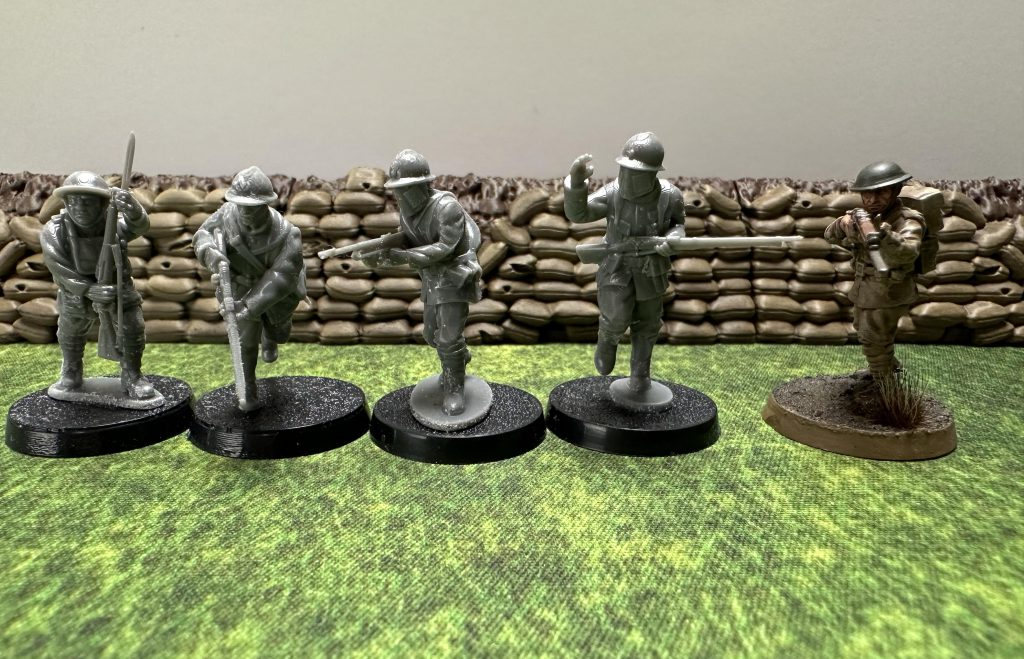
Quality and Printability
The real appeal of the Scouts Out! models is that they’re wonderfully dynamic, especially the specialist models. Pointmen leap into action, knives out. Snipers calmly line up a shot. Sappers and Saboteurs get ready to beat someone to death with a shovel.
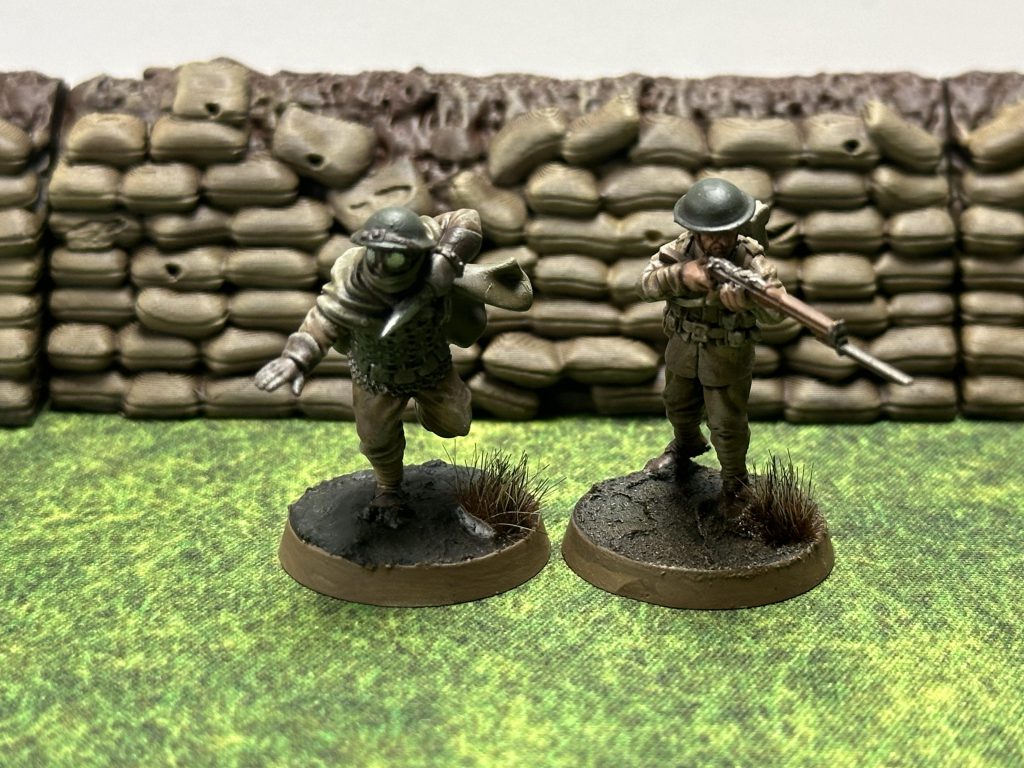
They’re really quite lovely.
The STLs come unsupported, with the “puddle” style bases that are familiar to most historical wargamers, along with 25mm and 32mm round base files. The models themselves are relatively easy to support – I tilted the models back 45 degrees and let Lychee’s auto support tools do most of the heavy lifting, making the supports lighter when they intersected with high-detail areas or weapons. As with many “realistically” proportioned historical miniatures, printing rifles and the like is always a bit stressful, as they are often about as thin as the support material, and the traditional “hot water and rip it off” method is extremely risky. But with a little care, I managed to remove supports without incident.
If I had one complaint about the design of the models, it’s that some of the puddle bases are fairly large, and overhang 25mm bases, requiring some filing down to fit at all.
Price
The French Patrol Pack is $16, for an officer, three soldiers, and a light machine gunner. That’s a decent price – the whole question of what STLs should cost is a somewhat unresolved. The single specialist figures, like this Arditi Pointman, are somewhat more expensive at $10, with little prospect for needing several of them. That’s a little dear for something you’ll have to print yourself, but it’s also something that one might expect to be fairly low volume.
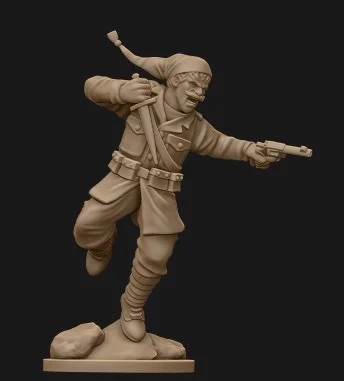
That being said, it’s a wildly characterful model. Just look at him and his little hat.
The biggest weakness of the line however is just that right now it just isn’t very big. Outside maybe the British or Germans (and even this is stretching it), you can’t really build a purely Scouts Out! models raiding party for Scouts Out!. That’s perfectly understandable, given the small size of the game, but I’d love to see the offerings here expand to cover most if not all of the core options. In the interim, they work for adding a dash of flair to raiding parties made up of other 28mm options.
Closing Thoughts
Overall, Scouts Out! is a rare and well designed Great War skirmish game. It does exactly what it sets out to do – create a fun, playable game that can be hammered out on a kitchen table in less than an hour. It would also be great as a sort of prelude/appetizer game to something that would take longer, or as the means to play out an entire short narrative campaign in the span of a single evening of gaming.
Generally, the games I have played seem to follow the same arc, where for a while the two forces peck at each other, until someone has a bad turn or two and things start to spiral. That’s not to say that isn’t a fun pattern to follow – there’s a very real sense of an attack stalling and losing momentum, and the survivors of the failed attack falling back to return to the relative safety of the trenches before the sun rises. And if things take a turn too fast, it’s easy enough to re-rack without that being a catastrophic waste of one’s evening.
While there’s room to grow – I’d personally love to see a book of missions and campaign rules – Scouts Out! is a game I can see myself wanting to play well into the future, especially with the game play options added in the expansion book. Overall, it’s an excellent way to start dabbling in the War to End All Wars.
Have any questions or feedback? Drop us a note in the comments below or email us at contact@goonhammer.com. Want articles like this linked in your inbox every Monday morning? Sign up for our newsletter. And don’t forget that you can support us on Patreon for backer rewards like early video content, Administratum access, an ad-free experience on our website and more.


